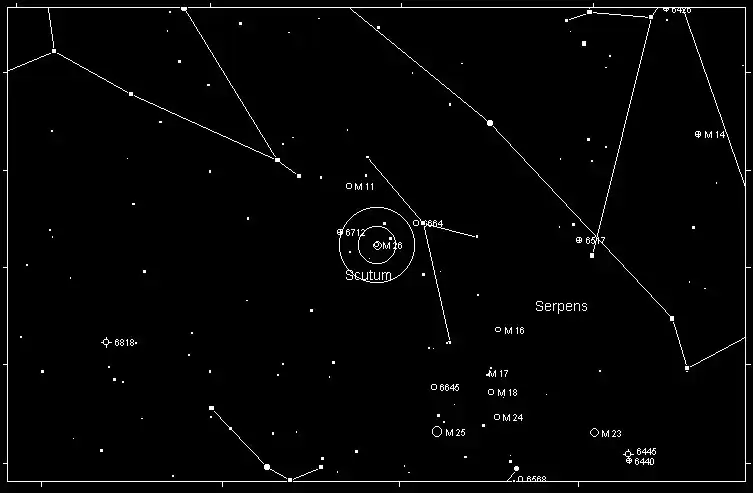Messier 26 (M26), also known as NGC 6694, is an open star cluster located in the constellation Scutum. This cluster is one of many discovered by the French astronomer Charles Messier, who cataloged objects that might be confused with comets. M26 is a relatively faint cluster, yet it contains around 90 stars, with an estimated age of approximately 89 million years. The cluster spans around 22 light-years across and lies about 5,000 light-years away from Earth. It provides a beautiful view when observed with a telescope, revealing stars of varying brightness levels within a dense stellar field.
Magnitude: The apparent magnitude of M26 is +8.0, which makes it difficult to observe with the naked eye. However, it is easily visible with small telescopes under good observing conditions. The brightest stars within M26 have an individual magnitude of around +10.2.
Seasonal Visibility
M26 is best observed during the summer months for observers in the Northern Hemisphere. The ideal time to view this cluster is from June to August when the constellation Scutum is high in the sky. Observing in dark-sky conditions is recommended to bring out the details of the stars within the cluster.
Constellation
Messier 26 is situated within the small and often overlooked constellation Scutum. Scutum, Latin for "shield," was named in honor of the Polish King John III Sobieski following his victory in the Battle of Vienna in 1683. Despite being a small constellation, Scutum is home to several star clusters, including the nearby Messier 11, also known as the Wild Duck Cluster.
How to Find Messier 26
To locate M26, begin by finding the larger and more prominent constellation of Aquila, which contains the bright star Altair. Scutum lies just south of Aquila and forms a small, shield-like pattern of stars. Within Scutum, look for the prominent star cluster M11, which is much brighter and easier to spot. Once you’ve identified M11, move your telescope approximately 3.5 degrees south of it to find M26. Under moderate magnification, the cluster will appear as a loose grouping of stars against the Milky Way’s rich background.

History
Charles Messier first discovered M26 on June 20, 1764. Messier's goal was to identify objects that could be mistaken for comets, and in doing so, he compiled his famous catalog of deep-sky objects. Although M26 isn’t as well-known or visually stunning as some other Messier objects, it remains a valuable target for amateur astronomers and a testament to Messier's thorough search of the night sky. Messier’s catalog, including M26, was primarily compiled using small telescopes of the time, and it continues to serve as an essential resource for astronomers today.
Conclusion
Messier 26 may not be as famous as other open clusters, but it offers a rewarding experience for stargazers looking for a challenge. Its location in the constellation Scutum, best viewed during the summer, makes it an intriguing target for those interested in exploring the Milky Way's rich stellar fields. With a modest telescope and a little patience, you can capture a glimpse of this ancient cluster and enjoy the beauty of the stars that Charles Messier first cataloged over two centuries ago.
